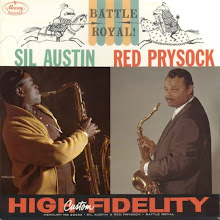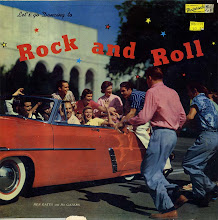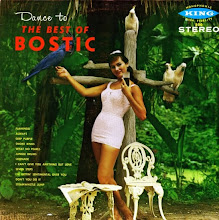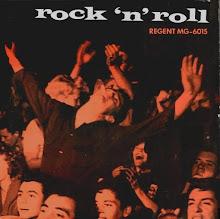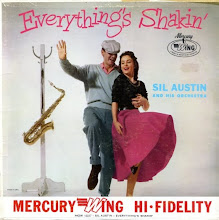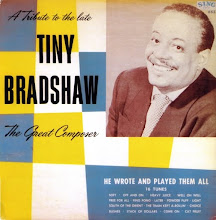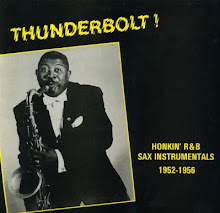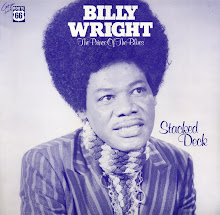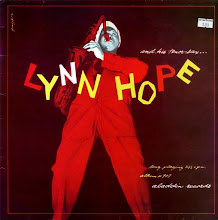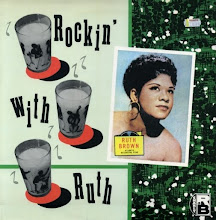Side 1
1. Thunder Storm *
2. Trouble, Trouble, Trouble
3. Hurricane **
4. Tough Enough
5. Windy City Hop
6. Earthquake ***
Side 2
1. Jump The Blues
2. Guided Missile
3. Good-Bye Little Girl
4. Wee, Wee Hours
5. Bobby Sox Ramble
* this is the 78 rpm version of "Hurricane."
** this track is not "Hurricane" but is in fact an alternate take of "Bobby Sox Ramble."
*** this track is "Atom Bomb" which was originally released as Imperial 5213.
As can be seen above, a number of errors were made in the attribution of titles to the above tracks. This was due to a number of factors, some dating back to the original issues on Imperial. There is a full explanation in the sleevenotes by Ken Mills to the Saxophonograph LP "Rockin' 'N' Boppin'." It should also be noted that some Joe Houston Imperial tracks were subsequently released on Bayou with different titles.
---------------------------------------------------------------------------------
“Cut for everybody and you’ll get a hit sooner or later,” said Big Joe Turner to his young tenor sax player Joe Houston back around 1950. And boy did young Houston take the advice to heart. So much so that trying to make sense of the Joe Houston discography has driven many an R&B fan to despair. To paraphrase Lord Palmerston (he was speaking of the Schleswig Holstein question): “the Joe Houston discography is so crazy, only three hep cats have ever really dug it. The first is six feet under. The second flipped his wig and is relaxing at Camarillo. The third is Jim Dawson who is still hanging on in there.”
But here at Be Bop Wino we laugh at minor details like matrix numbers and where and when sessions were held, and which sides were leased out to which companies, and which tunes were recycled under different titles. We just concentrate on the music itself and content ourselves with the knowledge that Joe Houston recorded some of the most blistering honking sax ever committed to wax.
He was born in 1926 in Austin, Texas. He started learning to play the trumpet at the remarkably early age of 11 but soon switched to alto sax, learning the solos of Charlie Parker and Joe Thomas from records. His first pro gig was with the King Kolax band with whom he toured the length of the United States and then shifted to blues shouter Gatemouth Moore’s band. He then toured with Amos Milburn’s backing band and decided to change over to tenor sax.
In 1949 he joined Big Joe Turner’s band for an extended engagement at the Ace of Clubs in Baton Rouge. Turner had cut some sides for the small Houston based Freedom label and on Big Joe’s recommendation not-so-big Joe went to Houston for his first recording session in November 1949. “Wee Wee Hours” and “Jump The Blues” are from that session. In March 1950 he recorded again for Freedom, with “Good-bye Little Girl” being included on this LP. The Freedom sides were standard jump blues, slightly rough around the edges and nothing to write home about. And there was no sign of the hellacious honking to come.
Sometime in late 1950 or early 1951 Joe recorded a four song session in Houston for a new local label, Macy’s. With three songs in the can, Joe cut loose on a wild and primitive honker for track number four. Released as “Blow, Joe, Blow” it sold well locally and was picked up by Los Angeles label Modern Records who were able to give it national distribution. In May 1951 Joe cut a couple of sides for a small Atlanta label, Sphinx. One of the tracks, “Worry, Worry, Worry,” was re-released on Mercury and became Joe’s biggest national hit, charting in February 1952. Meanwhile in August 1951 Joe Bihari of Modern Records arrived at Joe Houston's home in Baton Rouge with portable recording equipment and cut four sides, including another primitive screamer, “Houston’s Hot House” for release by the LA diskery.
Encouraged by his experience with the Biharis, Joe moved to Southern California, that land of fresh horizons and infinite opportunity, where by day the sun shone on the sparkling Pacific and by night beneath the twinkling stars hip teenagers gyrated sinfully to the eternal sax-driven riffs echoing from juke boxes, radios and live onstage late night battles of the hard rockin’ bands. Joe’s arrival way out West came at an opportune moment for rhythm and blues was breaking big in and around the City of Angels and black, chicano and white teens couldn’t get enough of it.
Big Jay McNeely was king of the tenor sax out there. Joe saw his wild stage act, copied it and was soon challenging Jay at live concerts. When we come to consider Joe’s recorded output at this time things get kind of complicated. Joe’s first LA sessions were for Lew Chudd’s Imperial label. Or maybe not, for he may have been cutting his first Combo sides at around this time too, and maybe sneaking in a quick session for Modern on the side.
Whatever was happening, we have now arrived at the bulk of the tracks on this LP which were recorded in May and July 1952 for Imperial. Some were re-workings of tracks he had already released on other labels. “Thunder Storm” (in reality the 78 rpm version of "Hurricane") is a slicker version of “Blow, Joe, Blow” on Modern, “Trouble, Trouble, Trouble” is basically a remake of his Mercury hit “Worry, Worry, Worry” and “Earthquake” (this is in fact "Atom Bomb") is a ringer for another Modern track, “Houston’s Hot House.”
It’s all fine rocking stuff, although the Freedom tracks which Imperial bought for re-release are in an obviously earlier style. From here on in the Joe Houston recording story gets incredibly complicated with sides being recorded for John Dolphin’s labels, the Biharis and Combo from late 1952 right through to 1959. His biggest local hit “All Night Long” was recorded for John Dolphin’s Money label towards the end of 1954 but was also released on Combo, Modern/RPM and Caddy. It was also re-recorded by Joe for a session which was released on the budget Tops label LP
“Rock and Roll with Joe Houston.” Discography fanatics should buy the Ace CD “Joe Houston Blows Crazy!” and read the liner notes by Jim Dawson. As for myself, my head is beginning to hurt with just thinking about it.
 |
| Original release of "All Night Long" on Money, 1954 (scan courtesy of Joan K) |
In the early 1960s the Biharis issued a number of Joe Houston LPs on their low budget Crown label. These bargain basement discs were aimed at exploiting current fads and so an increasingly unlikely series of Houston albums appeared on record racks in locations like supermarkets and grocery stores. Customers could buy a Joe Houston LP
to twist to, to limbo to, to surf to, and there was even one you could rock and roll to. Of course despite the different crazes they aimed to exploit, the LPs all sounded remarkably similar.
Unlike many of his contemporaries, Joe lived to see the revival of his kind of music in the 1980s and he was kept busy recording and touring right up into the present century. His most notable later recording was probably “The Return of Honk” with Otis Grand. Ill health brought an end to his active career in 2005.
Recommended purchases:
All the best Joe Houston sides have been released by the UK Ace label.
“Cornbread and Cabbage Greens” (Ace CDCHD 395) is now out of print. Billy Vera compiled this collection of Joe’s recordings for John Dolphin. Look out for it second hand.
“Honk! Honk! Honk!” (Ace CDCHD 781) is a compilation of screamin’ and rockin’ mid 1950s R&B from the vaults of Dootone and Combo. It includes 6 Joe Houston sides which originally appeared in the UK on the Ace LP “Rockin’ At The Drive-In.” Also on the CD are Chuck Higgins, Jack McVea, Roy Milton, Floyd Turnham and others. This is definitely in my top ten Ace CDs.
“Joe Houston Blows Crazy!” (Ace CDCHD 772) is a Jim Dawson compilation of Joe’s sides released on the Bihari labels – Modern, RPM and Crown. The sleeve notes tackle the complex Houston discography, including all those “twist” and “surf” LPs released on Crown. Included are the wildest of the wild – “Blow, Joe, Blow” and “Houston’s Hot House.”
Rockin’ At The Drive-In” (Ace CDCHD 994) is the CD issue of the LP issued by Ace back in the 1980s and by Combo back in the stone age. The definitive compilation of Joe’s Combo sides. The problem of 6 of the LP sides already being on “Honk! Honk! Honk!” is dealt with by using alternate takes. There’s plenty to delight the ear plus good liner notes by Tony Rounce. And you get that classic LP cover. Perhaps the finest 1950s LP cover of them all. Googie architecture, low riders, hand clapping teens, DJ Art Laboe, and Joe in an outrageously shoulder padded jacket. I’m in hog heaven.






























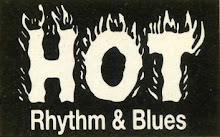
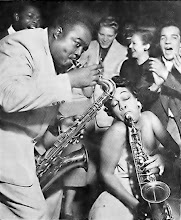




.jpg)


%2045%20-%201003A.png)
















